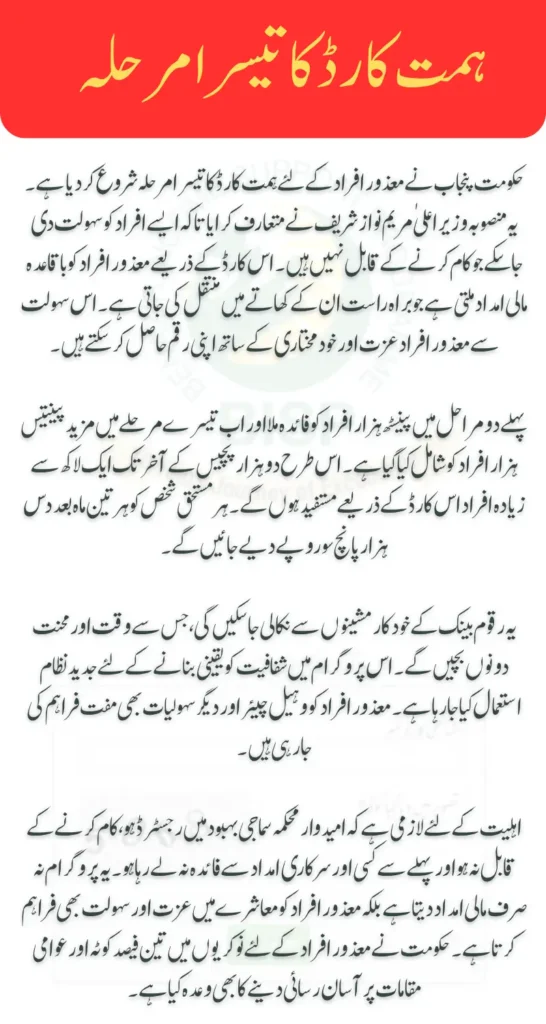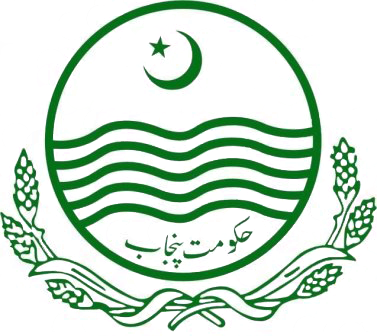The Government of Punjab has officially launched the third phase of the Himmat Card Programme in 2025 under the leadership of Chief Minister Maryam Nawaz Sharif. This initiative has been specially designed to provide steady financial assistance to persons with disabilities who are unable to work. By introducing this card, the government is ensuring equal opportunities, transparency, and independence for thousands of citizens across Punjab.

What is the Himmat Card Programme
The Himmat Card is a social welfare card that provides quarterly financial support to people with disabilities. Through this card, beneficiaries can directly withdraw their stipend from ATMs without relying on manual cash distribution, which often caused delays in the past.
You can also read: BISP 8171 SMS Issues Resolve Process October 2025 Complete Details
The programme is linked with the Bank of Punjab, which makes the process convenient and transparent. Each beneficiary receives Rs. 10,500 every quarter, ensuring they have a steady income to manage essential needs. This card will also be used for upcoming welfare projects related to persons with disabilities, making it a long-term initiative.
Key features of the Himmat Card:
- Quarterly stipend of Rs. 10,500
- Withdrawals through Bank of Punjab ATMs
- Linked with digital banking systems for transparency
- Inclusion in future disability welfare schemes
Launch of Himmat Card Phase 3
Phase 3 has been launched by the Punjab Social Welfare and Bait-ul-Mal Department. In the earlier phases, about 65,000 people benefited. Now, an additional 35,000 individuals are being included, taking the total beneficiaries to over 100,000 by the end of 2025.
You can also read: Minority Card Phase 2 Budget 2025-26, Along with New Eligible Criteria
During the launch ceremony, Himmat Cards and wheelchairs were distributed among deserving citizens. The Punjab Information Technology Board (PITB) and banking partners also joined this event to highlight the importance of digital inclusion and modern welfare systems. The programme is not only providing money but also mobility and dignity to disabled individuals.
Eligibility Criteria for Himmat Card
To make sure that only genuine applicants benefit from the scheme, the Punjab government has defined strict eligibility requirements. Applicants must fulfill these conditions before applying:
- Must be a certified person with disability registered with Social Welfare Punjab
- Should be medically declared unfit to work
- Must not have a government or private sector job
- Must not be receiving funds from Bait-ul-Mal, Zakat, PSPA, or BISP
- Poverty score (PMT) from BISP must not exceed 45
- CNIC, address, and mobile number should be updated in the DPMIS system
These rules make sure that the assistance goes to those who truly need financial help and are not already supported through other government schemes.
You can also read: Punjab Ration Card PSER Survey – Why It PSER Survey is Mandatory and How to Complete It
Step by Step Process of Receiving Stipend
The process of receiving financial support through the Himmat Card is simple and transparent. Once a person becomes eligible and receives their card, the stipend is directly transferred into the account every three months.
Steps include:
- Verification and approval of the applicant by Social Welfare Department
- Issuance of Himmat Card linked with the Bank of Punjab
- Quarterly stipend of Rs. 10,500 added to the card
- Beneficiaries withdraw money from Bank of Punjab ATMs anytime
This system reduces delays, ensures transparency, and protects the dignity of beneficiaries.
Programme Coverage in Numbers
To understand how the Himmat Card Programme has expanded, here is a simple table showing beneficiaries across different phases:
| Phase | Beneficiaries | Quarterly Stipend | Distribution Method |
|---|---|---|---|
| Phase 1 & 2 | 65,000 | Rs. 10,500 | ATM Card |
| Phase 3 | 35,000 | Rs. 10,500 | ATM Card |
| Total 2025 | 100,000+ | Rs. 10,500 | ATM Card |
The numbers show how the government is steadily increasing the reach of this welfare initiative with every phase.
Benefits of the Himmat Card
The Himmat Card is more than just financial assistance. It offers long-term advantages that improve the lives of persons with disabilities in Punjab.
Main benefits include:
- Regular financial assistance without delays
- Easy access to funds through ATMs across Punjab
- Free wheelchairs and mobility aids for improved independence
- Automatic inclusion in future disability-related schemes
- Dignity and respect in financial transactions without intermediaries
These benefits give individuals a sense of security and confidence, reducing their dependence on others.
You can also read: How the CM Punjab Laptop Program Phase 2 Rs 15 Billion Budget Will Benefit Students
Government Commitments
The government has made several commitments alongside the Himmat Card initiative to further support disabled individuals in Punjab. These include:
- Implementing a 3% job quota for disabled persons in government departments
- Providing free mobility aids such as wheelchairs and sticks
- Improving accessibility in public and private infrastructure
- Continuing financial and social assistance programmes through the Himmat Card
Such commitments reflect a long-term vision to empower persons with disabilities rather than simply offering short-term relief.
Conclusion
The launch of Himmat Card Phase 3 is a major milestone in Punjab’s journey toward inclusivity and social protection. With more than 100,000 individuals benefiting from the scheme by the end of 2025, this programme is a strong example of how modern welfare systems can bring dignity, independence, and financial stability to vulnerable groups.
You can also read: Punjab Ration Card PSER Survey
By focusing on digital solutions and structured financial aid, the government has created a model that can inspire similar initiatives across Pakistan. The Himmat Card is not just about money it is about empowerment, equality, and respect for persons with disabilities.

